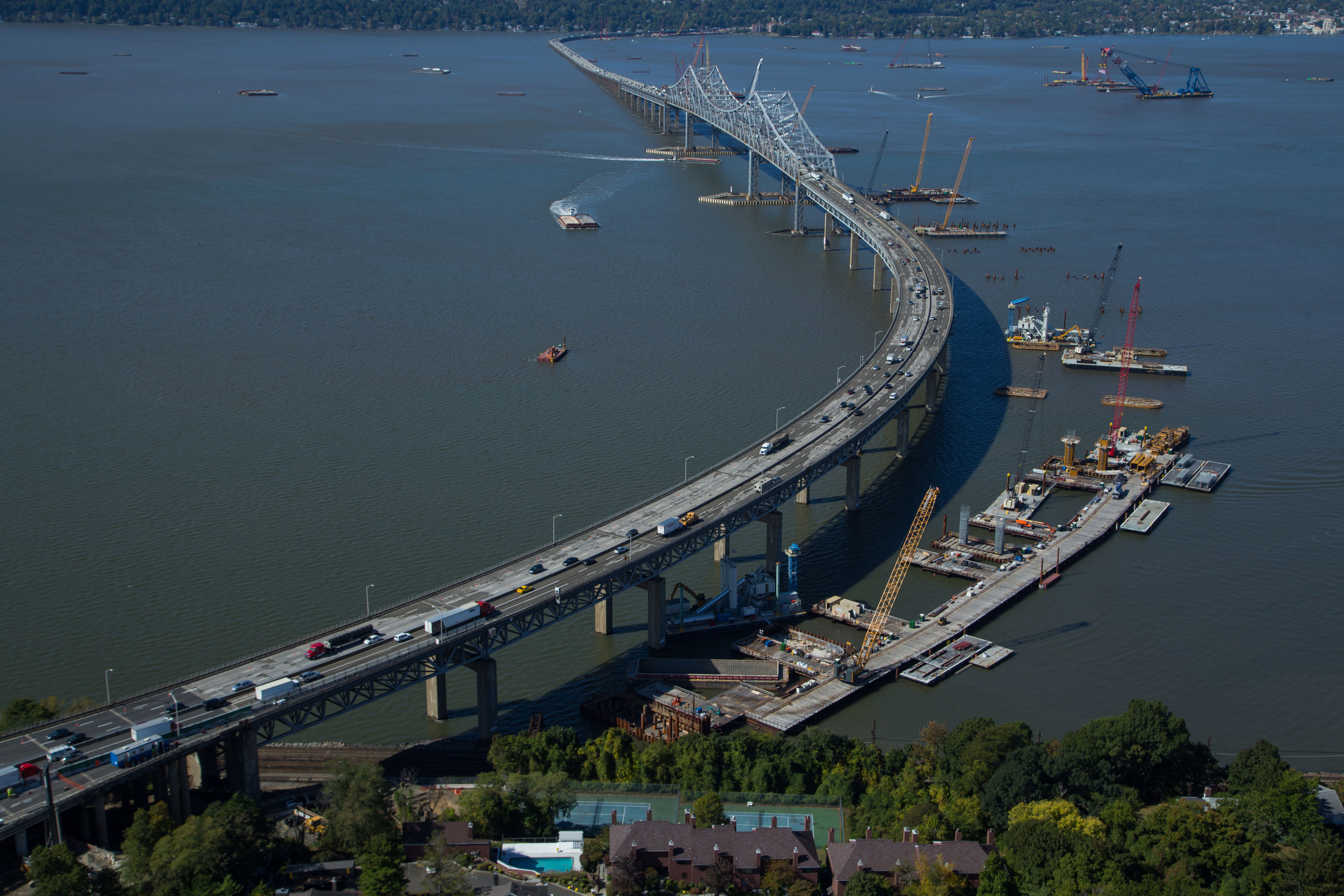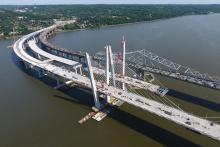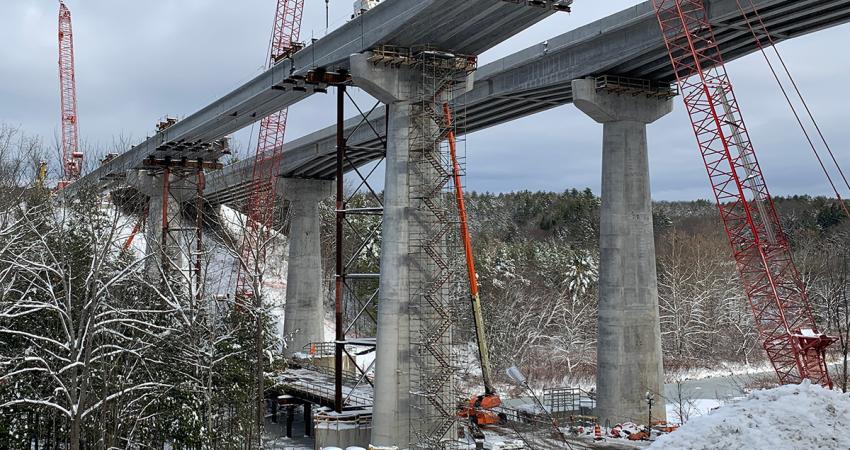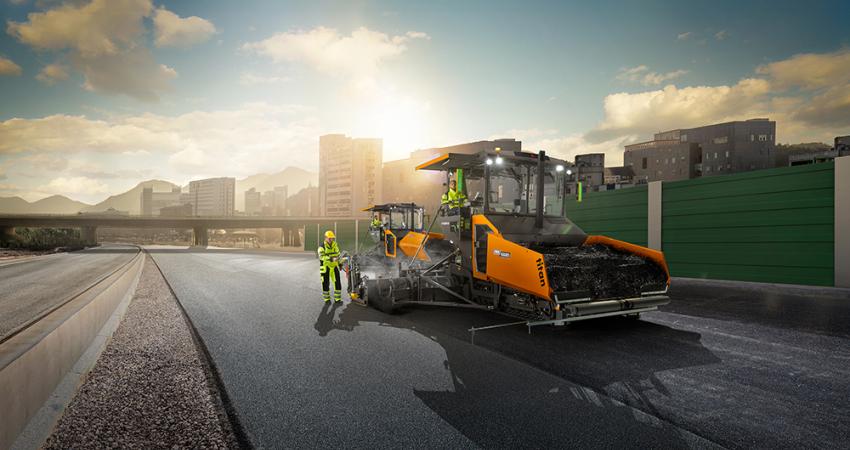Innovation, from design to on-site execution, is alive and well, thanks to a good helping of software application. David Arminas reports from software developer Bentley’s annual global conference, held this year in London
Successful project delivery is increasingly about hard men and women using software to get the job done and this year’s global conference in London by US-based software developer Bentley highlighted some innovative - and startling - examples.
As usual, the Year in Infrastructure 2014

Tappan Zee Hudson River Crossing, the New NY Bridge, in Westchester, New York (Photo Credit: New York State Thruway Authority)
RSSInnovation, from design to on-site execution, is alive and well, thanks to a good helping of software application. David Arminas reports from software developer Bentley’s annual global conference, held this year in London
Successful project delivery is increasingly about hard men and women using software to get the job done and this year’s global conference in London by US-based software developer4019 Bentley Systems highlighted some innovative - and startling - examples.
As usual, the Year in Infrastructure 2014 event in November had a gala evening where Bentley’s Be Inspired Awards showcased major infrastructure works including road, bridge and tunnel projects.
The common thread was how to make the best use of software to overcome design and construction challenges. The breadth of projects was impressive, taking in, apart from highways work, contracts in offshore oil platforms, manufacturing plants, power and chemical plants, liquefied natural gas terminals and harbour developments.
The Advancing Comprehensive BIM award was taken by engineering design firm2418 HDR for its Tappan Zee Hudson River Crossing, the New NY Bridge, in Westchester, New York. The original bridge crosses the Hudson River at one of its widest points. But the 27m wide cantilever structure is pushing 60 years old, well past its 50-year expectancy and carrying around 138,000 vehicles daily. It is due for closure in 2017 by which time some of the new 5km Tappan Zee Bridge should be open.
In 2013, the New York State Thruway Authority began building the new $3.9 billion eight-lane bridge, a double-span design of four lanes per span in opposite directions. It’s also designed to take a rapid transit rail line between the two road decks in future without major reinforcing or widening.
The majority of steel girder spans, 106m long, will be constructed along the river and barged to the site for installation by the Left Coast Lifter - a barge supporting a crane with a 100m boom and a lift capacity of just over 1,600 tonnes. The crane will lift an entire span that includes everything except the precast concrete deck. The bridge will have precast pile caps and precast concrete decks; the only cast-in-place concrete are the columns.
“I think that we just about used every single software tool that Bentley had to offer,” said Luigi Nimpo, CAD manager and BIM lead at design firm HDR, part of the Tappan Zee Consortium that includes design, engineering and construction firms6343 Fluor, 1021 American Bridge, Granite and 2760 Traylor Brothers.
“Most of the design work was done in Microstation and Inroads software, for coordination of the geo-coordinates,” said Nimpo. “New York State wanted the bridge to be geo-spacially located on their files. There were around 1,000 users on the project, based around North America: in Kansas City, in Canada, New York, Florida and Dallas.”
The old bridge had an accident rate of twice the state average, suffered often and severe congestion and had no mass transit capability. The new bridge has extra-wide shoulders for emergency use and space for express public bus use. Importantly, it’s built to last a century without major repairs.
Michigan’s Department of Transportation picked up the award for Advancing Information Technology with its move from a paper-based construction process to a completely electronic one. “No more paper. End of story,” said Stuart Laakso, a technical leader in the department's working group. “We use mobile devices on all our construction sites to get documents out. Contractors now have access to all our data, all our forms. That’s paperless for every project in the entire state,” he said.
But it’s been a tough cultural challenge to get away from believing you have to have a piece of paper in your hand. “Operatives used to struggle carrying boxfuls of plans and documents, cluttering up their vehicles as well. The ability to search through a document rather than having to flip through pages and pages has been an advantage in the field,” he said. “I have 35-year veterans sometimes getting connected up faster than 18-year old kids.”
Laakso has helped train department employees as well as contractors’ employees in going paperless. The state pays for its supply chain partners to have licences for the software. They get back that expense through supply chain efficiency savings. But while they have access to the DoT database, they can’t create their own databases.
One of the most expensive projects undertaken since going paperless in 2012 has been the start in February of a $115 million urban freeway project in Detroit. “It was an accelerated project where we shut down the entire seven miles [11km] of freeway for eight months, reconstructed it, and reopened. We could not have done this without going paperless and using Bentley’s Project Wise,” he said.
The winner of the Advancing Urban Infrastructure was the design for the yet-to-be built Santos-Guaruja tunnel project, a first for immersed tunnel work in Brazil. Importantly, it will drastically reduce the crossing time across the kilometre-wide bay that separates the two Atlantic coastal municipalities of Santos and Guarujá, around 80km from Sao Paulo.
It may be only 1.7km long, but it will cut out a 45km route that includes a bridge all too often congested with heavy goods vehicles – a journey of over an hour. By ferry, the crossing is only 20 minutes but often has a 90-minute rush-hour wait. The $1.3 billion project including access roads is a joint venture by Engevix Group, Themag and Planservi for the client2529 DERSA, a company owned by the state of Sao Paulo and which is responsible for some state-built highways. Estimated completion date is March 2018.
“The most difficult aspect of the project so far has been the sharing of information among partners, but we have been using Project Wise, as we have done for many projects in Brazil for several years,” said Franciane Menegazzo Araujo,a civil engineer within Engevix. As a job leader for the geometrical layout project, she has spent 18 months designing lanes, viaducts and other roadside furniture leading up to and away from the proposed tunnel entrances.
Putting in place the tunnel sections will require all river traffic to be stopped, “as well as some cooperation from the weather gods for quiet waters”, said Araujo, who gained valuable experience designing a ringroad around Sao Paulo.
The tunnel’s three sections will be built on land, sealed off at each end and removable water ballasts attached. They will be suspended underneath huge pontoons that tug boats push out into the bay. Ballast will be removed and the sections slowly sink into a trench, to be filled in and with a protective layer on top.
A tunnel in each direction for vehicles will be separated by a third tunnel for pedestrians and cyclists. At each end of the tunnel as it emerges from the river, there will be separate exits and entrances for pedestrians and cyclists, for safety reasons, said Araujo.
The Innovation in Bridges Award was taken by the Anhui Transport Consulting & Design Institute for its Second Wuhu Yangtze River Highway Bridge near the city of Wuhu in China’s south-eastern Anhui province. Much of the overall 55km project is a raised highway to protect thousands of small farms. The Wuhu project rose above stiff competition, including from2644 Hanson Professional Services for its work on a bi-modal bridge as part of Alaska’s 140km Northern Rail Extension from the southern coast northwards. Phase one of the line is the bridge that now crosses the Tanana River at Salcha, allowing year-round land access to a large isolated military base. It previously had been reachable by land only in winter when the river freezes.
Other winners include, in the Innovation in Megaprojects category, the1662 Jacobs and 979 Bouygues Civil Works Florida project Port of Miami Tunnel and Access Improvements. The Well-Connected Alliance took top honours in the Innovation in Roads category for its Waterview Connection project in Auckland, New Zealand. The alliance includes Fletcher Construction, MacDow, 2401 Obayashi Corporation, 2671 Beca, 2693 Parsons Brinckerhoff and Tonkin and Taylor. Both projects are highlighted in the October 2014 issue of World Highways. RSS
Successful project delivery is increasingly about hard men and women using software to get the job done and this year’s global conference in London by US-based software developer
As usual, the Year in Infrastructure 2014 event in November had a gala evening where Bentley’s Be Inspired Awards showcased major infrastructure works including road, bridge and tunnel projects.
The common thread was how to make the best use of software to overcome design and construction challenges. The breadth of projects was impressive, taking in, apart from highways work, contracts in offshore oil platforms, manufacturing plants, power and chemical plants, liquefied natural gas terminals and harbour developments.
The Advancing Comprehensive BIM award was taken by engineering design firm
In 2013, the New York State Thruway Authority began building the new $3.9 billion eight-lane bridge, a double-span design of four lanes per span in opposite directions. It’s also designed to take a rapid transit rail line between the two road decks in future without major reinforcing or widening.
The majority of steel girder spans, 106m long, will be constructed along the river and barged to the site for installation by the Left Coast Lifter - a barge supporting a crane with a 100m boom and a lift capacity of just over 1,600 tonnes. The crane will lift an entire span that includes everything except the precast concrete deck. The bridge will have precast pile caps and precast concrete decks; the only cast-in-place concrete are the columns.
“I think that we just about used every single software tool that Bentley had to offer,” said Luigi Nimpo, CAD manager and BIM lead at design firm HDR, part of the Tappan Zee Consortium that includes design, engineering and construction firms
“Most of the design work was done in Microstation and Inroads software, for coordination of the geo-coordinates,” said Nimpo. “New York State wanted the bridge to be geo-spacially located on their files. There were around 1,000 users on the project, based around North America: in Kansas City, in Canada, New York, Florida and Dallas.”
The old bridge had an accident rate of twice the state average, suffered often and severe congestion and had no mass transit capability. The new bridge has extra-wide shoulders for emergency use and space for express public bus use. Importantly, it’s built to last a century without major repairs.
Michigan’s Department of Transportation picked up the award for Advancing Information Technology with its move from a paper-based construction process to a completely electronic one. “No more paper. End of story,” said Stuart Laakso, a technical leader in the department's working group. “We use mobile devices on all our construction sites to get documents out. Contractors now have access to all our data, all our forms. That’s paperless for every project in the entire state,” he said.
But it’s been a tough cultural challenge to get away from believing you have to have a piece of paper in your hand. “Operatives used to struggle carrying boxfuls of plans and documents, cluttering up their vehicles as well. The ability to search through a document rather than having to flip through pages and pages has been an advantage in the field,” he said. “I have 35-year veterans sometimes getting connected up faster than 18-year old kids.”
Laakso has helped train department employees as well as contractors’ employees in going paperless. The state pays for its supply chain partners to have licences for the software. They get back that expense through supply chain efficiency savings. But while they have access to the DoT database, they can’t create their own databases.
One of the most expensive projects undertaken since going paperless in 2012 has been the start in February of a $115 million urban freeway project in Detroit. “It was an accelerated project where we shut down the entire seven miles [11km] of freeway for eight months, reconstructed it, and reopened. We could not have done this without going paperless and using Bentley’s Project Wise,” he said.
The winner of the Advancing Urban Infrastructure was the design for the yet-to-be built Santos-Guaruja tunnel project, a first for immersed tunnel work in Brazil. Importantly, it will drastically reduce the crossing time across the kilometre-wide bay that separates the two Atlantic coastal municipalities of Santos and Guarujá, around 80km from Sao Paulo.
It may be only 1.7km long, but it will cut out a 45km route that includes a bridge all too often congested with heavy goods vehicles – a journey of over an hour. By ferry, the crossing is only 20 minutes but often has a 90-minute rush-hour wait. The $1.3 billion project including access roads is a joint venture by Engevix Group, Themag and Planservi for the client
“The most difficult aspect of the project so far has been the sharing of information among partners, but we have been using Project Wise, as we have done for many projects in Brazil for several years,” said Franciane Menegazzo Araujo,a civil engineer within Engevix. As a job leader for the geometrical layout project, she has spent 18 months designing lanes, viaducts and other roadside furniture leading up to and away from the proposed tunnel entrances.
Putting in place the tunnel sections will require all river traffic to be stopped, “as well as some cooperation from the weather gods for quiet waters”, said Araujo, who gained valuable experience designing a ringroad around Sao Paulo.
The tunnel’s three sections will be built on land, sealed off at each end and removable water ballasts attached. They will be suspended underneath huge pontoons that tug boats push out into the bay. Ballast will be removed and the sections slowly sink into a trench, to be filled in and with a protective layer on top.
A tunnel in each direction for vehicles will be separated by a third tunnel for pedestrians and cyclists. At each end of the tunnel as it emerges from the river, there will be separate exits and entrances for pedestrians and cyclists, for safety reasons, said Araujo.
The Innovation in Bridges Award was taken by the Anhui Transport Consulting & Design Institute for its Second Wuhu Yangtze River Highway Bridge near the city of Wuhu in China’s south-eastern Anhui province. Much of the overall 55km project is a raised highway to protect thousands of small farms. The Wuhu project rose above stiff competition, including from
Other winners include, in the Innovation in Megaprojects category, the






